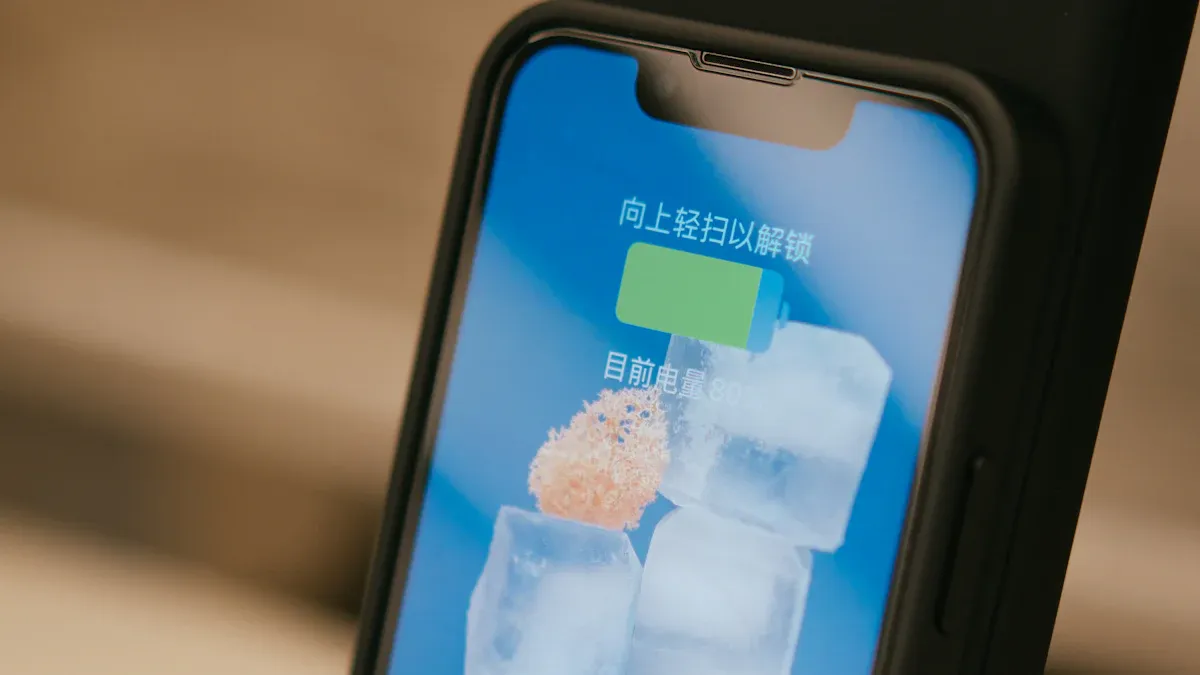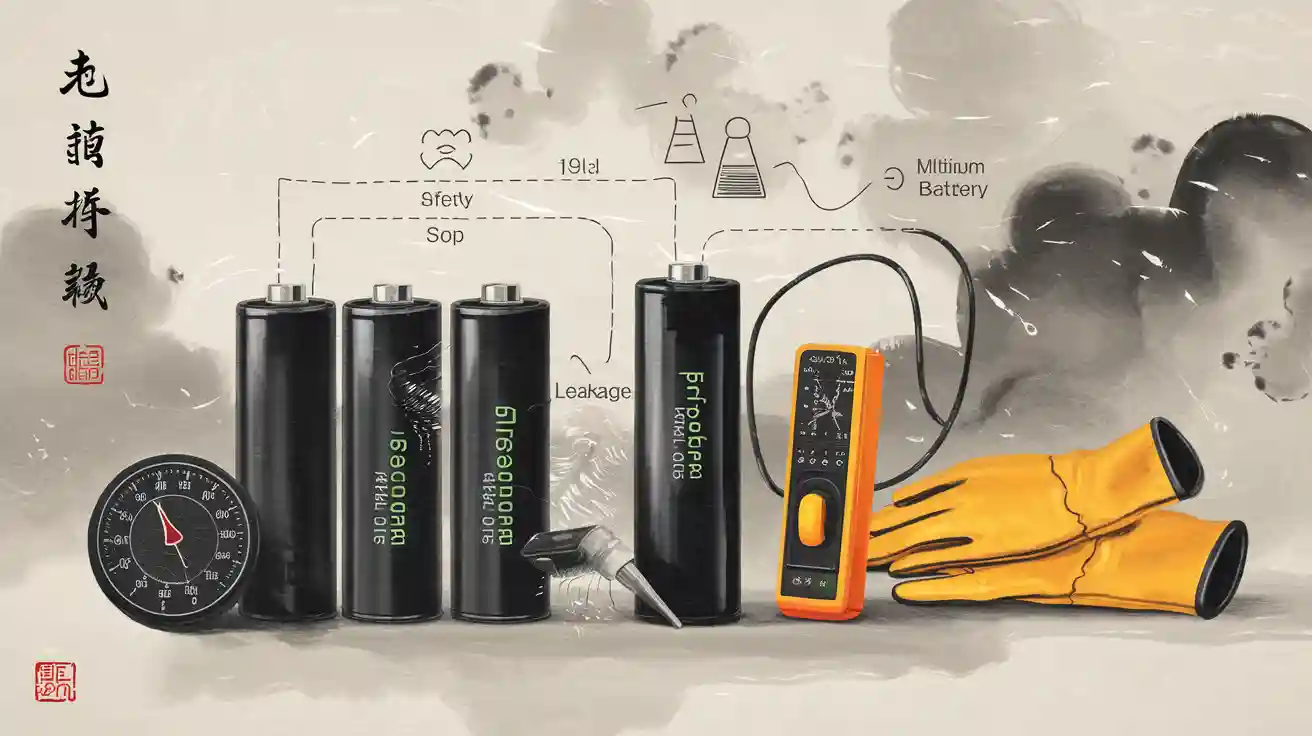Analysis of Major Lithium Battery Problems and Practical Solutions
You often face common problems with lithium battery performance, including voltage inconsistency, high internal resistance, expansion, and even explosion risks. The table below highlights these issues:
| Problem Type | Description |
|---|---|
| Voltage Inconsistency | High self-discharge and uneven current can lead to low voltage. |
| Internal Resistance | Long storage or device differences increase internal resistance. |
| Battery Expansion | Overcharging or processing errors may cause swelling. |
| Power Loss After Spot Welding | Incorrect welding leads to voltage drop and power loss. |
| Explosion Risks | Overcharging or overcurrent can trigger battery explosions. |
Understanding the cause of each problem helps you choose the right solution and improve battery safety. Use these solutions to maintain your devices and prevent future failures.
Key Takeaways
- Regularly monitor your lithium battery's voltage and internal resistance to catch issues early and maintain optimal performance.
- Store lithium batteries in a cool, dry place to minimize self-discharge and prevent capacity loss.
- Use chargers specifically designed for your lithium battery type to avoid overcharging and potential safety hazards.
Common Problems with Lithium-Ion Batteries
You often encounter several common problems when using lithium-ion batteries. These issues can affect performance, safety, and the lifespan of your devices. Understanding the causes of lithium-ion battery failures helps you find the right solution and prevent future failures. Below are the main types of failures you may face:
- Voltage inconsistency from self-discharge and uneven charge.
- High internal resistance due to long storage or testing errors.
- Battery expansion during charging or from processing mistakes.
| Issue Type | Description |
|---|---|
| Thermal Runaway | A critical safety concern where batteries can catch fire or explode due to overheating. |
| Internal Resistance | Increased resistance can lead to reduced performance and efficiency of the battery. |
| Battery Expansion | Physical swelling of the battery can occur due to overcharging or prolonged use, affecting safety. |
Voltage Inconsistency
Voltage inconsistency remains one of the most frequent failures in lithium-ion batteries. You may notice uneven charge between cells, which leads to unpredictable performance and shortens battery life. Laboratory tests show that even a small change in open-circuit voltage (OCV) can cause a significant shift in state of charge (SOC). For example, a 1 mV change in OCV may result in a 5% SOC difference. Hysteresis effects can cause OCV variations of over 50 mV during charge and discharge, making it harder to estimate battery health. These voltage swings often signal deeper issues, such as loss of active material or lithium inventory, which directly impact performance and reliability.
Low Voltage
Low voltage is another common problem in lithium-ion batteries. You might experience this after deep discharges, overdischarge, or exposure to temperature extremes. Overdischarge can cause irreversible damage, while high discharge rates and internal short circuits also contribute to failures. Both high and low temperatures can reduce performance, making your battery less reliable. Uneven charge across cells can further increase the risk of low voltage, especially in older or heavily used batteries.
High Internal Resistance
High internal resistance leads to energy loss and heat generation during charging and discharging. You may notice your li-ion battery heats up quickly or loses capacity faster than expected. For 18650 cells, resistance above 20-80 mΩ is problematic, while for LiFePO4 cells, values above 2-20 mΩ indicate trouble. High internal resistance reduces efficiency, limits performance, and shortens the lifespan of your lithium battery. This issue often results from long storage, testing inaccuracies, or repeated failures. Addressing internal resistance early can help you maintain optimal performance and avoid more serious failures.
Tip: Regularly monitor your battery’s voltage and internal resistance to catch problems early and apply the right solutions.
Lithium Battery Self-Discharge Issues
Causes of Self-Discharge
You may notice that lithium-ion batteries lose charge even when not in use. This process is called self-discharge. It leads to low voltage and reduced performance, especially if you store batteries for long periods. On average, lithium-ion batteries experience a self-discharge rate between 0.5% and 3% per month. High self-discharge can cause large self-discharge failures, making your devices unreliable.
Several chemical and physical mechanisms drive self-discharge in lithium-ion batteries. The table below outlines the main causes:
| Mechanism Type | Description |
|---|---|
| Chemical Side Reactions | Moisture reacts with the electrolyte, generating hydrofluoric acid (HF), damaging the SEI layer, leading to capacity loss. |
| Electrolyte Decomposition | Decomposition of electrolyte components under high voltage forms byproducts that consume active lithium. |
| Positive Electrode Reaction | At high charge states, reactions between the positive electrode material and electrolyte lead to capacity loss. |
| Negative Electrode Issues | Metal impurities react with conductive carbon, forming a galvanic cell, leading to metal ion dissolution and dendrite formation. |
Physical self-discharge also occurs. Heat, vibration, and mechanical actions can accelerate voltage drops, especially at high temperatures. These failures reduce battery performance and shorten lifespan.
Note: Regular monitoring helps you detect self-discharge early and prevent unexpected failures.
Solution for Self-Discharge
You can manage self-discharge and improve lithium-ion batteries performance by following proven solutions. Store batteries in a cool, dry place to minimize heat exposure. Use quality chargers with maintenance modes to keep optimal charge levels. Avoid complete drainage by implementing regular charging and discharging cycles. These steps help you reduce large self-discharge failures and maintain consistent performance.
- Store batteries away from direct sunlight and moisture.
- Use chargers designed for lithium-ion batteries with smart features.
- Charge and discharge batteries regularly, but avoid deep discharges.
By applying these solutions, you extend the lifespan of your lithium battery and prevent performance loss. Consistent management reduces failures and keeps your devices reliable.
Li-Ion Battery Expansion

Causes of Expansion
You may notice swelling or deformation in lithium-ion batteries during use or charging. This battery expansion signals serious failures that can impact both performance and safety. Overheating often triggers these changes, but several internal mechanisms also play a role. Failure analysis reports identify the following common causes:
| Common Causes of Lithium-Ion Battery Expansion |
|---|
| Structural changes of active materials |
| Phase transitions of active materials |
| Cracks or breakage of active particles |
| Dissolution of transition metals |
| Volume expansion |
| SEI overgrowth |
| SEI decomposition |
| Lithium dendrite growth |
| Electrolyte decomposition or failure |
| Insufficient electrolyte |
| Mismatch of electrolyte additives |
| Corrosion or dissolution of current collector |
| Failure of conductive agent |
| Failure of binder |
| Failure of diaphragm aging |
| Blocking of diaphragm pores |
| Segregation of pole pieces |
| Material agglomeration |
| Abnormal cell design |
| Abnormal cell aging process |
Dendrite growth stands out as a critical failure mechanism. It usually develops at the anode–electrolyte interface, especially when you charge batteries rapidly at low temperatures. This process can cause internal short circuits, leading to thermal runaway and overheating. These failures reduce battery performance and increase the risk of catastrophic events.
Solution for Expansion
You can prevent or reduce lithium-ion battery expansion by following proven solutions. These steps help you maintain performance and avoid overheating or other failures:
- Avoid overcharging. Unplug your device once it reaches full charge to prevent overheating.
- Keep your devices cool. Store and use lithium-ion batteries in a cool, dry place to minimize overheating.
- Use appropriate chargers. Always select chargers designed for your specific battery to avoid failures.
- Do not deplete batteries completely. Recharge when the battery drops to around 20% to protect performance.
Tip: Regularly check your devices for signs of swelling or overheating. Early detection helps you avoid more serious failures and keeps your lithium battery safe.
By following these solutions, you improve battery performance, reduce the risk of battery expansion, and protect your devices from overheating.
Over-Discharge and Charging Failure
Causes of Over-Discharge
Over-discharge happens when you drain a lithium battery below its safe voltage threshold. This condition often results from improper usage and non-optimal charging practices. When you push a battery past its lower voltage limit, the internal protection circuit may activate and lock the battery. Locked batteries cannot accept a charge, which leads to charging failure. Over-discharge also causes chemical changes inside the cell, reducing performance and increasing the risk of permanent damage. Devices left unused for long periods or exposed to extreme temperatures face a higher risk of over-discharge.
Note: Over-discharge can make your battery unresponsive to standard charging, so early detection is essential.
Solution for Charging Failure
You can restore a lithium battery that fails to charge by applying targeted solutions. First, check if the battery protection circuit has activated. In many cases, a simple reset can unlock the battery. Disconnect the battery from all devices and chargers for at least 30 minutes. This process resets the Battery Management System (BMS) and often restores charging capability.
If the battery remains unresponsive, try deep cycle charging. Use a compatible RC balance charger to manually charge each cell. This method can revive cells that standard chargers cannot detect. Always monitor temperature during charging to prevent overheating.
| Method | Description |
|---|---|
| BMS Reset | Disconnect battery for 30 minutes to reset protection circuit |
| Deep Cycle Charging | Use a RC balance charger to manually charge cells |
You should always use chargers designed for your battery type. Avoid exposing batteries to extreme heat or cold during charging. These solutions help you recover from charging failure and maintain reliable performance.
Storage and Capacity Loss in Lithium Batteries
Storage-Related Problems
You may notice that improper storage can cause significant capacity loss in lithium battery packs. When you store batteries in poor conditions, you risk permanent performance decline. Field studies show that several storage-related problems can affect the longevity of your batteries:
| Problem Type | Description |
|---|---|
| Conductivity Loss (CL) | Collector corrosion and binder decomposition increase internal resistance. |
| Loss of Lithium Inventory (LLI) | Lithium plating, dendrite growth, and SEI film issues reduce available capacity. |
| Loss of Active Material (LAM) | Fragmentation, structural decay, and binder decomposition lead to capacity loss. |
High temperatures speed up electrolyte and active material degradation. Low temperatures increase internal resistance and reduce capacity. Humidity and physical damage also contribute to these failures. You need to understand these risks to maintain the performance of your lithium battery packs.
Solution for Storage Issues
You can prevent storage-related failures by following best practices for proper storage and handling of lithium battery packs. Here are some effective solutions:
- Store batteries in a cool, dry place. The ideal temperature is around 15°C (59°F).
- Avoid exposing batteries to extreme temperatures or moisture.
- Handle batteries carefully to prevent physical damage.
- Charge batteries at a slow rate and avoid overnight charging.
- Use chargers rated for about one-quarter of the battery’s capacity.
Tip: Consistent proper storage and handling of lithium battery packs helps you minimize capacity loss and extend battery life.
By applying these solutions, you protect your lithium battery from unnecessary degradation and ensure reliable performance for your devices.
Manufacturing Defects in Lithium-Ion Batteries
Common Defects
You may encounter manufacturing defects in lithium battery packs that impact both safety and performance. These defects account for about 10% of all lithium-ion battery failures. The most frequent issues include impurities, uneven coatings, and electrode misalignment. Such problems can lead to swelling, leaking, or even thermal runaway.
| Category | Common Defects |
|---|---|
| Safety Risks | Swelling/leaking cells, Thermal runaway risks, Poor insulation, Inadequate venting mechanisms |
| Performance Issues | Capacity deviation (>±5%), High self-discharge rate, Voltage inconsistency, Cycle life below standard |
| Construction Defects | Spot-weld failures, Damaged separators, Poor sealing, Loose terminal connections |
You should pay attention to these defects because they can cause rapid capacity loss or unpredictable device behavior. Even small construction errors, like loose terminals or damaged separators, can create major safety hazards.
Solution for Defects
You can reduce the risk of manufacturing defects in lithium battery packs by choosing products from manufacturers with strict quality control. Leading factories use clean facilities and automation to prevent contamination and human error. They also rely on advanced inspection methods, such as X-ray verification and ultrasonic welding, to catch hidden defects.
- Cleanroom assembly with HEPA filtration keeps impurities out.
- Precision robotics and automated laser profilometers ensure correct electrode placement and coating thickness.
- Regular sample testing and formation testing check cell capacity and performance before batteries leave the factory.
You should also look for batteries certified under ISO 9001, UN38.3, and IEC 62619 standards. These certifications show that the manufacturer follows strict safety and quality guidelines. By selecting certified products and trusted brands, you protect your devices and ensure long-term performance. If you suspect a defect, stop using the battery and contact the supplier for a solution or replacement.
Lithium Battery Safety Risks and Explosions

Causes of Safety Risks
You face serious hazards when using lithium battery technology. Fire hazards and explosions in lithium-ion batteries have become more common as global demand rises. Recent studies show:
- The global demand for lithium-ion batteries will increase nearly sevenfold between 2022 and 2030.
- About 24% of all electric vehicle fires come from lithium-ion batteries.
- Major cities like New York and San Francisco have reported over 660 fires linked to these batteries in six years.
- From 2021 to 2023, New York City recorded at least 12 deaths and over 260 injuries due to battery explosion incidents.
You need to understand the main hazards that cause explosions and runaway events. These include:
- Short circuits, both internal and external
- Insufficient negative electrode capacity, which can lead to lithium deposition and short circuits
- High moisture content, increasing internal pressure and explosion risk
- Aging protection circuit failure
- Overcharge explosion and over-discharge
- External extrusion or violent collision
- Overcurrent explosion
Each hazard can trigger runaway reactions inside the cell. Runaway leads to rapid heating, gas buildup, and sometimes a battery explosion. You must recognize these hazards to prevent catastrophic runaway events.
Solution for Safety
You can reduce hazards and prevent explosions by following industry-recommended solutions:
- Always use chargers made for your device to avoid overcharging and overheating.
- Store batteries in cool, dry places away from heat sources.
- Regularly inspect batteries for leaks, swelling, or cracks.
- Remove devices from chargers once fully charged to prevent runaway.
- Cover battery ends with tape before disposal to avoid short circuits.
- Use special storage boxes to prevent gas buildup and explosions.
- Check batteries weekly or monthly for any signs of damage.
- Ensure battery connections are tight and free from rust.
- Safely dispose of old or damaged batteries at designated drop-off locations.
- Look for products certified by a Nationally Recognized Testing Laboratory, such as CSA, ETL, or UL Solutions.
- Use appropriate PPE, like gloves and safety glasses, when handling batteries.
- Avoid charging or discharging beyond safe limits to prevent runaway and battery explosion.
- Work on non-conductive surfaces and remove combustibles from the charging area.
By following these solutions, you protect yourself from hazards, improve battery performance, and reduce the risk of runaway and explosions. Stay alert to warning signs and always handle lithium battery products with care. If you have questions about hazards or battery explosion risks, feel free to reach out and join the discussion below.
You can address lithium battery issues by following proven solutions and regular maintenance.
- Monitor voltage and check for damage monthly.
- Store batteries in cool, dry places.
- Use approved chargers and avoid deep discharge.
- For how to revive lithium battery performance, keep charge between 20% and 80% and update software.
These steps improve performance and safety.
FAQ
What should you do if your lithium battery overheats during charging?
Unplug the device immediately. Let the battery cool in a safe, ventilated area. Check for swelling or leaks before using it again.
How can you safely dispose of a damaged lithium battery?
- Place tape over the terminals.
- Use a designated battery recycling center.
- Never throw lithium batteries in regular trash.
Why does your lithium battery lose charge quickly even when not in use?
| Cause | Solution |
|---|---|
| High self-discharge | Store in cool, dry place |
| Battery aging | Replace if necessary |
Have more questions? Leave a comment below and join the discussion!
-

 May.2025.11.24Ternary Lithium Battery vs Lithium-ion: Complete Comparison Guide (2025 Edition)Learn More
May.2025.11.24Ternary Lithium Battery vs Lithium-ion: Complete Comparison Guide (2025 Edition)Learn More -

 May.2025.11.214S2P 18650 14.8V Battery: Complete Technical Guide, Specs, Applications & SafetyLearn More
May.2025.11.214S2P 18650 14.8V Battery: Complete Technical Guide, Specs, Applications & SafetyLearn More -

 May.2025.11.18PCM vs BMS in Lithium Batteries: What’s the Difference and Which One Do You Need?Learn More
May.2025.11.18PCM vs BMS in Lithium Batteries: What’s the Difference and Which One Do You Need?Learn More -

 May.2025.11.17Custom Li-ion Battery Design for Medical Devices (2025 Comprehensive Guide)Learn More
May.2025.11.17Custom Li-ion Battery Design for Medical Devices (2025 Comprehensive Guide)Learn More -

 May.2025.11.17The Future of Lithium-Ion Batteries: Innovation, Sustainability, and Global Market TrendsLearn More
May.2025.11.17The Future of Lithium-Ion Batteries: Innovation, Sustainability, and Global Market TrendsLearn More
















